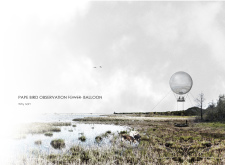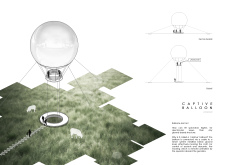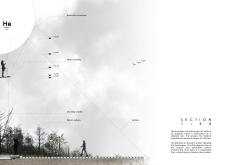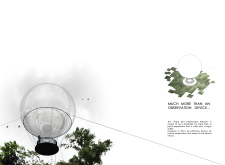5 key facts about this project
From the outset, the architecture reveals a commitment to sustainability and ecological sensitivity. The structure employs a careful selection of materials that not only support its visual appeal but also enhance its environmental performance. Notable materials include reinforced concrete, sustainably sourced timber, and high-performance glass, each chosen for their durability and aesthetic qualities. The use of green roofing systems further enhances the sustainability credentials of the project, providing an additional layer of insulation while contributing to the building's integration within the landscape.
In terms of spatial organization, the design promotes an open and fluid layout. Within the architectural plans, one can observe the deliberate arrangement of communal spaces that encourage gatherings and interactions among users. The design incorporates flexible areas that can be adapted to different functions, highlighting the architects' focus on practicality and user-oriented solutions. Natural light floods these spaces, thanks to strategically placed large windows that also offer picturesque views of the surrounding landscape. This not only boosts the occupants' well-being but also strengthens the connection between the interior and exterior environments.
Significantly, the architectural sections reveal the layered complexity of the project. Multiple levels are utilized creatively, allowing for a dynamic experience as one moves through the building. The careful consideration of vertical circulation enhances accessibility, ensuring that all users can navigate the space easily. The interplay between open areas and more intimate nooks creates varied experiences throughout, allowing for both socialization and solitude, depending on user preference.
Moreover, the design pays particular attention to cultural and contextual relevance. A thorough analysis of the local architectural vernacular has informed many design decisions, resulting in a structure that resonates with its geographical location. This serves not only to respect the existing milieu but also to celebrate the unique characteristics of the area, making the project a true reflection of its place.
One of the unique design approaches seen in this project is the integration of biophilic design principles, which emphasize the inherent connection between humans and nature. The incorporation of natural elements within the interiors—such as living walls and indoor gardens—invites nature inside, enhancing occupants' overall experience. This approach aligns with contemporary architectural trends that advocate for healthy living environments and emphasizes the role of nature in promoting mental well-being.
The exterior of the project does not shy away from modern aesthetics while maintaining a harmonious relationship with the natural surroundings. The façade features a combination of textures—smooth finishes from concrete, the warmth of wood, and the transparency of glass—creating a visually captivating profile. The rhythmic pattern of the structure's external elements not only serves an artistic purpose but also contributes to environmental performance by optimizing wind and solar access.
In conclusion, this architectural design stands as a testament to the thoughtful integration of form, function, and environment, embodying innovative ideas while ensuring a strong connection with its community and ecological context. The balance achieved between unique design elements and practical usability illustrates a commitment to enhancing the user experience. For those interested in delving deeper into this project, reviewing the architectural plans, architectural sections, and architectural designs will provide comprehensive insights into its thoughtful execution and innovative architectural ideas. Exploring these elements can enhance understanding and appreciation of this well-conceived architectural endeavor.


























